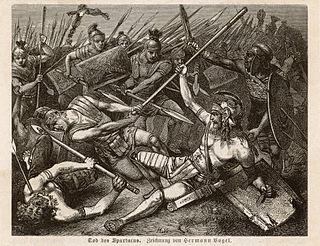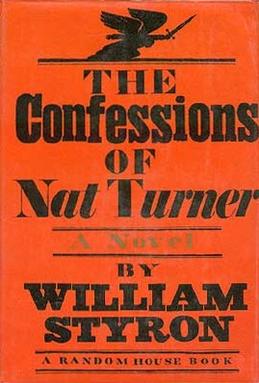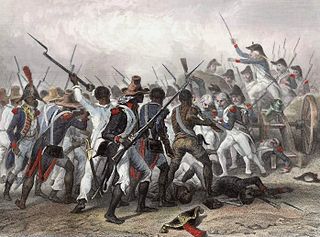Related Research Articles

1831 (MDCCCXXXI) was a common year starting on Saturday of the Gregorian calendar and a common year starting on Thursday of the Julian calendar, the 1831st year of the Common Era (CE) and Anno Domini (AD) designations, the 831st year of the 2nd millennium, the 31st year of the 19th century, and the 2nd year of the 1830s decade. As of the start of 1831, the Gregorian calendar was 12 days ahead of the Julian calendar, which remained in localized use until 1923.

A slave rebellion is an armed uprising by slaves, as a way of fighting for their freedom. Rebellions of slaves have occurred in nearly all societies that practice slavery or have practiced slavery in the past. A desire for freedom and the dream of successful rebellion is often the greatest object of song, art, and culture amongst the enslaved population. These events, however, are often violently opposed and suppressed by slaveholders.

Nat Turner was an enslaved African-American carpenter and preacher who led a four-day rebellion of both enslaved and free Black people in Southampton County, Virginia in August 1831.

Southampton County is a county located on the southern border of the Commonwealth of Virginia. North Carolina is to the south. As of the 2020 census, the population was 17,996. Its county seat is Courtland.

Courtland is an incorporated town in Southampton County, Virginia, United States. It is the county seat of Southampton County.

William Clark Styron Jr. was an American novelist and essayist who won major literary awards for his work.

Denmark Vesey was a free Black and community leader in Charleston, South Carolina, who was accused and convicted of planning a major slave revolt in 1822. Although the alleged plot was discovered before it could be realized, its potential scale stoked the fears of the antebellum planter class that led to increased restrictions on both enslaved and free African Americans.

The Baptist War, also known as the Sam Sharp Rebellion, the Christmas Rebellion, the Christmas Uprising and the Great Jamaican Slave Revolt of 1831–32, was an eleven-day rebellion that started on 25 December 1831 and involved up to 60,000 of the 300,000 slaves in the Colony of Jamaica. The uprising was led by a black Baptist deacon, Samuel Sharpe, and waged largely by his followers. The revolt, though militarily unsuccessful, played a major part in the abolition of slavery throughout the British Empire.

The Confessions of Nat Turner is a 1967 Pulitzer Prize-winning novel by American writer William Styron. Presented as a first-person narrative by historical figure Nat Turner, the novel concerns Nat Turner's Rebellion in Virginia in 1831, but does not always depict the events accurately. It is based on The Confessions of Nat Turner: The Leader of the Late Insurrection in Southampton, Virginia, a first-hand account of Turner's confessions published by a local lawyer, Thomas R. Gray, in 1831.

Thomas Taylor Munford was an American farmer, iron, steel and mining company executive and Confederate colonel and acting brigadier general during the American Civil War.

Events from the year 1831 in the United States.

Malik Zulu Shabazz is an American attorney. He has previously served as Chairman of the New Black Panther Party, which is labeled as a hate group. As of 2013, he is the current National President of Black Lawyers for Justice, which he co-founded.

Nat Turner's Rebellion, historically known as the Southampton Insurrection, was a rebellion of enslaved Virginians that took place in Southampton County, Virginia, in August 1831. Led by Nat Turner, the rebels killed between 55 and 65 White people, making it the deadliest slave revolt for white people in U.S. history. The rebellion was effectively suppressed within a few days, at Belmont Plantation on the morning of August 23, but Turner survived in hiding for more than 30 days afterward.
William Craik was an American lawyer and planter who served as a United States representative from Maryland and as a state judge.

Thomas Roderick Dew was a professor and public intellectual, then president of The College of William & Mary (1836-1846). Although he first achieved national stature for opposing protective tariffs, today Dew may be best known for his pro-slavery advocacy.
James Trezvant was a U.S. Representative from Virginia. He was also a slave owner.
William Henry Brodnax, was a nineteenth-century American militia Brigadier General and American politician from Virginia.
James Strange French (1807–1886) was a lawyer, novelist, and later hotel keeper.
Nat Turner: A Troublesome Property is a 2003 documentary film about Nat Turner co-written and directed by Charles Burnett.

Slave rebellions and slave resistance were means of opposing the system of chattel slavery in the United States from 1776 to 1865. According to Herbert Aptheker, "there were few phases of ante-bellum Southern life and history that were not in some way influenced by the fear of, or the actual outbreak of, militant concerted slave action." Slave rebellions in the United States were small and diffuse compared with those in other slave economies in part due to "the conditions that tipped the balance of power against southern slaves—their numerical disadvantage, their creole composition, their dispersal in relatively small units among resident whites—were precisely the same conditions that limited their communal potential." As such, "Confrontation in the Old South characteristically took the form of an individual slave's open resistance to plantation authorities,"or other individual or small-group actions, such as slaves opportunistically killing slave traders in hopes of avoiding forced migration away from friends and family.
References
- ↑ Allmendinger, David F. (2014). Nat Turner and the rising in Southampton County. Baltimore. p. 216. ISBN 978-1-4214-1480-5. OCLC 889812744.
{{cite book}}: CS1 maint: location missing publisher (link) - ↑ Allmendinger, David F. (2014). Nat Turner and the rising in Southampton County. Baltimore. p. 218. ISBN 978-1-4214-1480-5. OCLC 889812744.
{{cite book}}: CS1 maint: location missing publisher (link) - ↑ Allmendinger, David F. (2014). Nat Turner and the rising in Southampton County. Baltimore. p. 219. ISBN 978-1-4214-1480-5. OCLC 889812744.
{{cite book}}: CS1 maint: location missing publisher (link) - ↑ Allmendinger Jr., David (2014). Nat Turner and the Rising in Southampton County. Baltimore. p. 218. ISBN 978-1-42141479-9.
- ↑ Allmendinger, David F. (2014). Nat Turner and the rising in Southampton County. Baltimore. p. 216. ISBN 978-1-4214-1480-5. OCLC 889812744.
{{cite book}}: CS1 maint: location missing publisher (link) - ↑ Allmendinger, David F. (2014). Nat Turner and the rising in Southampton County. Baltimore. pp. 219–220. ISBN 978-1-4214-1480-5. OCLC 889812744.
{{cite book}}: CS1 maint: location missing publisher (link) - ↑ Brophy, Alfred L. (June 2013). "The Nat Turner Trials". North Carolina Law Review . 91: 1817–1880. Archived from the original on 2016-04-07. Retrieved 2020-07-23.
- ↑ Southampton Co., VA, Court Minute Book 1830-1835. pp. 121–123. Archived from the original on 2017-11-11. Retrieved 2018-04-27.
- ↑ Proceedings on the Southampton Insurrection, Aug-Nov 1831, archived from the original on 2016-08-25, retrieved 2018-04-27
- ↑ Allmendinger Jr., David (2014). Nat Turner and the Rising in Southampton. Baltimore. p. 220. ISBN 978-1-42141479-9.
- ↑ Brundage, W. Fitzhugh; Greenberg, Kenneth S. (2004-05-01). "Nat Turner: A Slave Rebellion in History and Memory". The Journal of Southern History. 70 (2): 24. doi:10.2307/27648419. ISSN 0022-4642. JSTOR 27648419.
- ↑ Allmendinger Jr., David (2014). Nat Turner and the Rising in Southampton. Baltimore. p. 221. ISBN 978-1-42141479-9.
- ↑ Allmendinger Jr., David (2014). Nat Turner and the Rising in Southampton. Baltimore. p. 222. ISBN 978-1-42141479-9.
- ↑ Brundage, W. Fitzhugh; Greenberg, Kenneth S. (2004-05-01). "Nat Turner: A Slave Rebellion in History and Memory". The Journal of Southern History. 70 (2): 37. doi:10.2307/27648419. ISSN 0022-4642. JSTOR 27648419.
- ↑ French, Scot A. "The Confessions of Nat Turner". Encyclopedia of Virginia. Archived from the original on 2013-05-30. Retrieved 2013-08-21.[ dead link ]
- ↑ Fabricant, Daniel S. “Thomas R. Gray and William Styron: Finally, A Critical Look at the 1831 Confessions of Nat Turner.” The American Journal of Legal History, vol. 37, no. 3, 1993, pp. 332–61. JSTOR website Retrieved 23 Sept. 2023.
- ↑ Brundage, W. Fitzhugh; Greenberg, Kenneth S. (2004-05-01). "Nat Turner: A Slave Rebellion in History and Memory". The Journal of Southern History. 70 (2): 7. doi:10.2307/27648419. ISSN 0022-4642. JSTOR 27648419.
- ↑ Tomlins, Christopher (2016-04-02). "Looking for Law in 'The Confessions of Nat Turner'". Rochester, NY. SSRN 2760657.
{{cite journal}}: Cite journal requires|journal=(help)